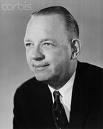 In 1972 ‘Roger’s Roundtable’, as it was affectionately called by supporters, merged with two other groups to form the Business Roundtable. One of these groups was the March group. It had been formed by Fred Borch, chair of General Electric (GE), John Harper, chair of Alcoa, together with Bryce Harlow, head of Procter & Gamble’s Washington office, and consisted of a select group of CEOs of major US companies who met informally to discuss public policy issues.
In 1972 ‘Roger’s Roundtable’, as it was affectionately called by supporters, merged with two other groups to form the Business Roundtable. One of these groups was the March group. It had been formed by Fred Borch, chair of General Electric (GE), John Harper, chair of Alcoa, together with Bryce Harlow, head of Procter & Gamble’s Washington office, and consisted of a select group of CEOs of major US companies who met informally to discuss public policy issues.
The March group was the outcome of a private meeting between Borch, Harper, a member of Roger’s Roundtable and three high level government officials. The businessmen were concerned at the increasing public resentment toward American business. Present at the 1972 meeting were Arthur Burns, Chair of the Federal Reserve Bank, Charls Walker, Deputy Treasury Secretary, and John Connally, Secretary of the Treasury. Walker was a business economist with a background in banking and several years lobbying government on behalf of the banks as executive vice president of The American Bankers Association (1961-69).
 Connally was a lawyer, who had been involved in the Texan Suite 8F Group, a group of right wing men from politics and business who met in suite 8F of a Houston hotel beginning in the 1930s through to the 1970s. The group aimed primarily to protect oil industry interests in Texas and included men from Brown & Root, American General Insurance Company, Kerr-McGee Oil Industries, and the Governor of Texas. Lyndon B. Johnson was also a member. Connally became governor of Texas himself in 1963 and then a businessman before going back into politics.
Connally was a lawyer, who had been involved in the Texan Suite 8F Group, a group of right wing men from politics and business who met in suite 8F of a Houston hotel beginning in the 1930s through to the 1970s. The group aimed primarily to protect oil industry interests in Texas and included men from Brown & Root, American General Insurance Company, Kerr-McGee Oil Industries, and the Governor of Texas. Lyndon B. Johnson was also a member. Connally became governor of Texas himself in 1963 and then a businessman before going back into politics.
Connally and Walker advised the businessmen to found an organization of business CEOs which would directly lobby Congress and the White House to adopt policies that suited corporations. The March Group was formed, gathering together more than forty CEOs from the largest corporations.
The other group in the merger was the Labor Law Study Group (LLSG). It had been set up in the mid 1960s to oppose union power and weaken labour laws with the help of in a major anti-labour public relations campaign orchestrated by Hill & Knowlton.The LLSG was made up of twelve ‘thought leaders’, men who were top corporate labour relations executives from the largest corporations and belonged to ‘all the trade associations in every nook and cranny in the country’. They were known as ‘the Twelve Apostles’. By 1968 the campaign was being described as the “broadest united front of large and small businesses in history”.
In the early 1970s the LLSG was turning its attention to government regulation and its costs to business as well as the need to create a more business-friendly climate of public opinion. Its mergers with the March Group and with Roger’s Roundtable was unsurprising given the considerable overlap in the membership of all three groups.
Thus, the BRT was born in 1972 with Borch and Blough as co-chairmen initially, followed by John Harper as Chairman from 1973-76.